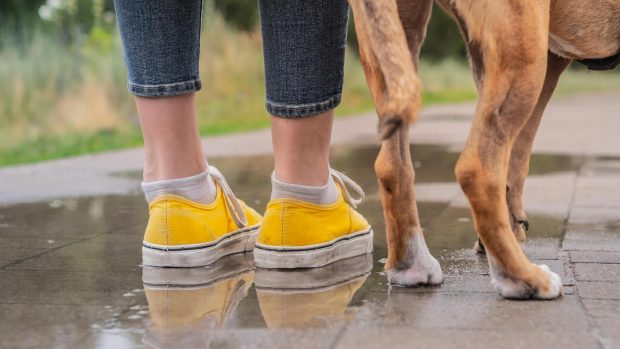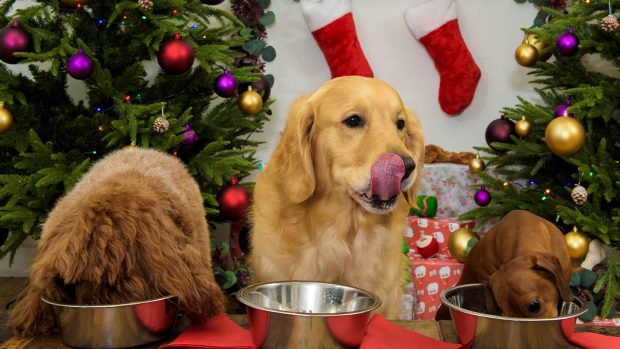There’s lots to think about when you’re getting a new puppy – from do you have the best puppy bed and have you planned how to puppy-proof your house, to what you’re going to call it (check out some ideas for girl dog names, boy dog names and funny dog names if you’re still undecided). Something that doesn’t get thought about enough is puppy fear periods. Knowing what they are, when to expect them and how to support your puppy through them will help your puppy mature into a confident and content adult dog.
What are puppy fear periods?
A fear period is a stage all dog goes through to reach maturity. Most behaviourists and scientists are of the opinion that there are two fear periods during this time up until adulthood – whereas I believe there are three and they coincide with important milestones in your puppy’s development. During the fear periods, puppies may show signs of stress or fear for no apparent reason and their ability to bounce back may appear impaired. It’s important to make puppies feel as safe as possible while they’re going through a puppy fear period – you can do this by controlling their environment so that they know you’re the safe person and that you have their back no matter what.
It’s unfortunate that the making of a fearful adult dog can be traced back to a negative or traumatic experience that took place during these critical periods, that wasn’t dealt with in the correct way. It’s also not uncommon for owners to force their dogs into situations they find stressful or frightening on a regular basis during the fear period time, which creates a reactive or fearful dog through lack of knowledge and understanding. The experience the puppy has may have not been really traumatic itself, but because it occurred during one of the puppy fear periods, it can have a stronger impact than if it happened at another time.
Fear itself is not necessarily a bad thing. It’s an instinctual response that helps protect us from harm. It’s how we respond to these trauma episodes as an owner that will leave a lasting impact on your dog going forward – so it’s imperative we get it right.
When are puppy fear periods?
First fear period
The first real fear period of note comes between eight and 11 weeks, which coincides with the time you would usually pick up your puppy from a breeder. This is when puppies are at their most sensitive, so there are arguments both for and against getting them at eight weeks or leaving it until they’re 12 weeks.
In the wild, puppies of eight to 11 weeks would be moving out of the den and establishing more connections with the social group. In a domestic setting, however, this time coincides with the pups going to their new homes, meeting their new owners and going to the vet for their vaccinations. These are major life events and fears can be triggered.
At this age, the puppy is also in his critical socialisation period, so it’s important not to expose him to traumatic experiences that may have a long-lasting effect. For example, if a puppy is accidentally stepped upon at nine weeks old, he may develop a chronic fear of feet or shoes. This is why I am so adamant I will not put pressure on a dog’s neck with a lead and collar combination due to the feelings it causes and the health implications it can cause. Having never felt pressure like this, the last thing they want to encounter is a feeling of being strangled. Any encounter that involves a lead should be a positive one so they don’t associate the lead with fear and pain.
Many phobic reactions in adult dogs may originate from experiences that occurred during this period. During this time, pups may show reactions to things that they previously had no response to. A puppy’s vision isn’t fully functioning until around 10 weeks old, so it’s possible that this sight adjustment period, along with the confusion it may cause, is one of the contributing factors to this first fear period.
Second (and third) fear period
Scientific studies suggest the next fear period occurs between six and 14 months. From experience I have found that more often than not, the next fear period tends to coincide with puberty (between 6 and 9 months) – we then start to see things that previously weren’t a problem for the dog that now caused them to react or be afraid. For example, a happy, confident puppy who enjoys meeting other dogs and interacting reaches puberty and either have a dog attack them or play too roughly, which hurts them. The next time they see another dog, they can become fearful and panicked (trying to flee) or they are loud and reactive (trying to get in first as a form of defence). This scenario requires specialist help in order to help the dog cope, overcome the trauma and move forward positively without holding onto the fear for the rest of his life.
I then tend to see another fear period in a dog just before maturity – between 12 and 18 months. Similarly, a dog that wasn’t sensitive to bangs or loud noises can experience a fright and then the slightest noise sends them into a panic. Dealing with this the right way (with professional help if necessary) is paramount to a happy, well-balanced dog moving into adulthood, as opposed to a quivering wreck every time a door bangs.
Signs that your dog is in a fear period
- Acting afraid of new people, animals and objects they may or may not have seen before.
- Easily scared by sudden movements, loud noises or changes to their environment.
- A severe change in behaviour after experiencing something unpleasant – for example, a hoover may have spooked them and now they won’t enter the room if it’s in there whether it’s switched on or not.
- Growling and lungeing and whatever spooked them.
- Reacting to other dogs after a traumatic experience, such as an attack or rough play.
- Shying away, hiding and trembling at things – these maybe things that previously did not phase your pup.
- The following behaviours and body language in every setting: licking, yawning, looking away, freezing or moving more slowly, holding their ears back, tucking their tail, panting, showing the whites of their eyes, refusing treats or lowered body postures.
Common things puppies fear
- Strangers
- Being handled/touched
- Loud noises
- Unfamiliar objects
- People coming to the door
- Traffic – trucks, busses, trailers
- Children
- Men
How to help your dog through the fear period
Most of the time, you can wait it out as these puppy fear periods pass. Your dog will regain their confidence again, providing you don’t inadvertently add to the fear. However, because there is a potential to make a lasting negative association with a single bad experience during this time, you want to approach this period of time with some understanding and extra preventative measures.
What to do
- Allow them to explore the world at their own pace.
- Comfort your puppy when he is feeling scared – do not say “good girl” or “good boy” as you are affirming the fear, try saying “I’ve got you” instead to comfort them without affirming the fear.
- Pair scary situations, noises, people or objects with treats, but xontrol the environment and the dogs panic pacing before rewarding. This will help him to make positive associations.
- Build his confidence through training using positive reinforcement.
- Use one of the best dog calming supplements to help reduce stress and promote relaxation – although I would only consider this in the older puppy. You can also use other dog calming products, such as Adaptil, which a synthetic appeasing pheromone (and can be found here on Amazon).
What to avoid
- Avoid traumatic experiences where possible. Consider staying away from the areas where everyone walks their dogs and busy streets where there is more potential for a bad experience to occur.
- Don’t make a big deal when your puppy reacts – reassure and redirect.
- Don’t punish your puppy for barking, lungeing or growling – be proactive and manage the behaviour before it starts.
- Don’t push them into uncomfortable situations, such as forcing them to accept being handled, walked, or to interact with strangers.
- Don’t ignore them when they’re seeking you out for comfort.
- Don’t let yourself get frustrated –it’s normal and part of dog ownership.
- Avoid over-exposing them to frightening stimuli in the hope that this cures the problem as it will only make it worse.

Adaptil Calming Spray at amazon.co.uk
This spray contains a synthetic copy of the “dog appeasing pheromone”, which a mother naturally releases to calm and reassure her litter.

Zylkene Calming Supplement at amazon.co.uk
Contains alpha caseophine – a natural milk protein with clinically proven calming properties – and can easily be sprinkled on to food.
You might also be interested in:

Soothe anxiety with the best calming supplements for dogs

How to help an anxious dog

Sleep tight little one! Best puppy beds for sweet slumber

How to stop a puppy crying so that everyone gets a good night’s sleep

How to calm an overexcited puppy

How to house train with puppy pads, according to an expert dog trainer

Subscribe to Horse & Hound magazine today – and enjoy unlimited website access all year round
Horse & Hound magazine, out every Thursday, is packed with all the latest news and reports, as well as interviews, specials, nostalgia, vet and training advice. Find how you can enjoy the magazine delivered to your door every week, plus options to upgrade your subscription to access our online service that brings you breaking news and reports as well as other benefits.




